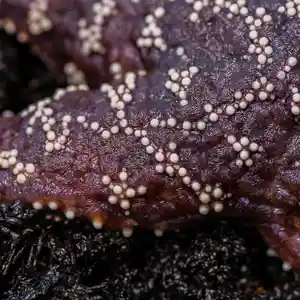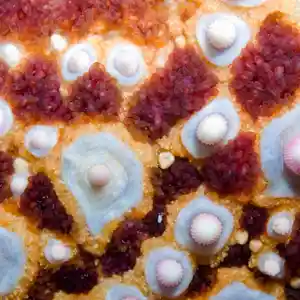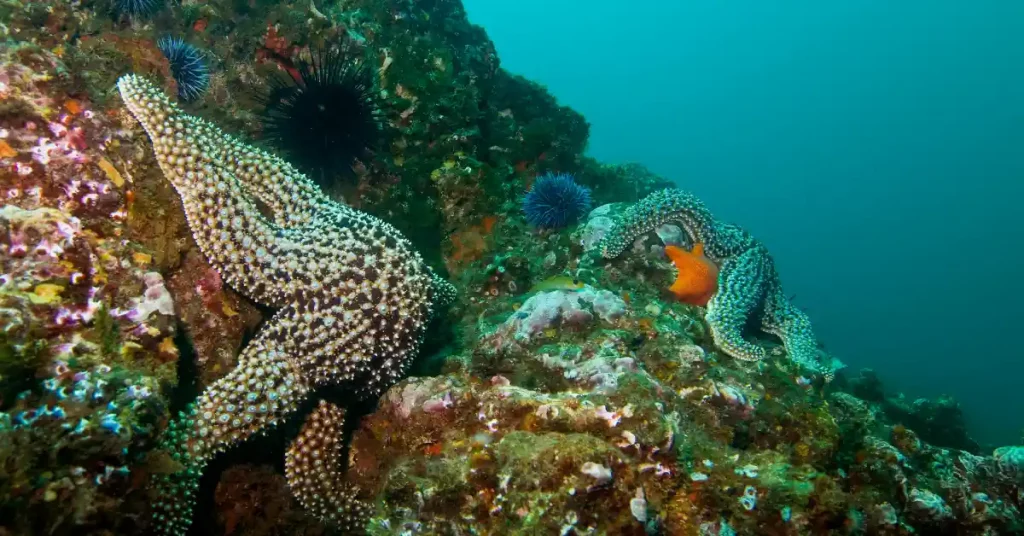Giant starfish is a beautiful and interesting marine animal, but they are also one of the most unusual. The way they move is one of the features that make them so different from other animals. The giant starfish is scientifically-referred to as the “Pisaster giganteus”.
The Giant Starfish is also known as the Leather Star, Sand Dollar, Sea Star, Sun Star, and Sea Urchin. The Giant Starfish, as their name suggests, can grow to quite a large size. Therefore, the giant starfish is one of the most interesting and beautiful sea creatures. These stars are considered invasive species due to their ability to overpopulate and displace other marine animals.
The Giant Starfish is well-known for its vibrant colors and beautiful shapes. They are very popular among underwater photographers and divers due to their unusual appearance. They are popular because of their bright colors, wide range, and ability to regenerate.
Diet & feeding Behavior
The giant starfish is a voracious hunter that eats all kinds of mussels, sea snails, barnacles, and even sea urchins. The strong arms of the starfish are used to pry open the shells of their prey. Their ability to pry open these shells is aided by their aboral surface which is covered with thousands of tiny tube feet that can generate a suction force. Once opened, they use their digestive system to digest the soft tissues while they leave behind the shell that remains undigested.
They can consume mussels and clams in large numbers. They have a good sense of smell and they hunt for their prey by detecting the smell of the prey nearby.
In order to be able to feed on smaller prey such as sea snails and other mollusks, they make use of the rough surface of their bodies to break the shells into smaller pieces that can be easily digested. Other large prey items include gastropods, bivalves, barnacles, limpets, and even other species of starfish. It also feeds on algae during low tide. When it reaches close to the prey, it attaches itself to the prey firmly by using its tube feet. After that, it starts pulling out the shell of the prey by opening its mouth widely.
After that, it inserts its stomach into the shell of the prey through its mouth and slowly digests the animal alive inside with the help of enzymes released from its stomach.
Natural Habitat
The Giant Starfish inhabits intertidal zones, and is usually found on rocky shores, but may be found in eelgrass beds or kelp forests. Giant starfish are found in the waters of the northeastern Pacific Ocean. The giant starfish is a common inhabitant of tide pools and shallow waters along the Pacific coast, from Baja California to Alaska. It can be found at depths of up to 160 feet (50 m). One of their favorite environments in intertidal zones, where they are exposed to both air and water.

These starfish can be found in a variety of reef environments at depths up to 130 feet, but they’re most commonly seen in tide pools. They prefer to live on hard substrates such as rocks and reefs, where they can forage for food and defend themselves from predators. These stars thrive in rocky areas that have plenty of algae for them to eat. They will also be found where there are enough other invertebrates for them to prey on such as mussels, barnacles, and snails.
This creature only lives in subtidal zones where the water is shallow enough for it to receive sunlight but not so shallow that it dries out during low tide.
Appearance & Color Range
The giant starfish is an excellent example of the saying “don’t judge a book by its cover”. Their incredible size and powerful appearance can be quite intimidating, but in reality, they are some of the easiest eaters to keep in your aquarium.
These creatures have a unique appearance that makes them stand out from other species in your tank. Both the top and bottom sides of their bodies are covered with spiny projections that make them look like a giant sea urchin.
The body of the giant starfish is usually colored either brown or orange. They are typically purple but can range in color from orange to reddish-purple to brown or olive green. Their color comes from their diet, which includes a rich source of carotene. They come from shallow waters near the coast, so they prefer a sandy substrate in your tank. One way you can identify the giant starfish is by the number of arms they have, which is usually five. They can have as many as forty arms and grow up to twelve inches long. The Giant Starfish can weigh up to two and a half pounds!
Reproduction and Breeding Cycle for the Giant Starfish
Giant starfish are hermaphrodites. This means that they have both male and female sex organs. However, a giant starfish will use one organ at a time when mating.
The mating season for the Giant Starfish begins in March and lasts until August. The eggs of each individual species of starfish will produce their own colors to help with identification. In the wild, giant starfish (or sunflower starfish) breed in the summer. The females are able to store sperm from previous matings for years. They can release them when they want and self-fertilize their eggs.
The breeding cycle of starfish varies from species to species and is influenced by environmental factors such as the temperature of the water and the availability of food. Giant starfish breed during the summer months. Giant starfish have a sexual reproductive system.
The breeding cycle is as follows:
Late spring to summer: giant starfish will spawn by releasing eggs and sperm into the water column. This is done simultaneously, with other individuals in the population, so fertilization can occur between genetically different starfish.
After fertilization occurs, the eggs begin to develop. The larvae are microscopic and are carried along by ocean currents for about a month before they settle onto the substrate, where they will start their new lives.
Some species of starfish are hermaphrodites and can produce offspring without needing a second individual. Others require two individuals to reproduce. In most species, this process begins with the release of sperm and eggs from the gonads. These gametes float into the water and then swim to another starfish by means of cilia.
When a sperm cell finds an egg, it penetrates it and fertilization takes place. The embryos develop inside transparent sacs or capsules called brooding pouches or marsupia. After several weeks, the larvae hatch from these pouches.
The young starfish is known as a bipinnaria larva. It has two eyespots and grows by feeding on tiny marine organisms in plankton. In most species, this stage lasts several months while they float on ocean currents before settling on the ocean floor and beginning their new lives as young starfish.
Predators and prey
Giant starfish are not only the largest species of starfish in the world, they are also one of the largest sea creatures. Giant starfish are voracious predators, feeding on a variety of marine bivalves and gastropod molluscs that live on the rocky seafloor. They are mainly nocturnal, emerging from their hiding places in crevices, under rocks, or beneath the kelp canopy after dark to hunt.
Pisaster have a number of natural predators including sea otters (Enhydra lutris), seagulls, bald eagles (Haliaeetus leucocephalus) and other fish. Juveniles can also be eaten by crabs and other fish.
The Giant Starfish is normally preyed upon by birds and fish, such as the California Sheephead and the Sea Otter. These animals are some of the only known predators that eat the sea star. The Giant Starfish also preys on fish, barnacles, snails, bivalves, worms, sea cucumbers, crabs, and other echinoderms. The Giant Starfish has a unique way of hunting its prey. When they find a bivalve or other invertebrate to eat they will attach themselves to it and make small movements with their arms.
This process can take hours to open up the shell or burrow of the prey because these movements are very slow. Once it has its meal opened up it will then use its stomach to enter the shell or burrow to eat its meal from the inside out. After eating so much its stomach is full it will retract back into its body and continue looking for more food.
Aquarium care for Giant sea star
A giant sea star is a big starfish that is known to attract the attention of hobbyists. The species is well-known for its unique colors, size, and behavior. It has a striking appearance that can make your aquarium look more interesting and attractive. They offer a unique look and help control the algae in your tank. They are also very easy to care for, and they are great for beginner aquarists.
Giant starfish do not need much space and are suitable for nano tanks. They do best in a mature tank with low levels of light, low current, and plenty of shelters. The temperature should be kept between 50-60 degrees Fahrenheit and the pH between 7.6-8.6. Giant Starfish will not survive in a saltwater tank that has been converted from freshwater, so it is best to start your aquarium off as a saltwater tank from the beginning.
The tank should have a strong water flow because these animals need a lot of oxygen. Aquarium filtration and water changes must be carried out using reverse osmosis or distilled water. Because they are detritivores, they will benefit from live rock that has been allowed to develop a biofilm layer. If kept in captivity without sufficient food, they will consume the dermal tissue of their skin to meet the nutritional requirements.

Waterflow should be strong, but the starfish should be able to move against it. If you have a choice, create a strong flow on one side of the tank so that the starfish can escape it if need be.
The decoration is optional. You can provide stones or an artificial reef, but Pisaster giganteus will not use these for shelter or hiding.
Lighting does not matter if Pisaster giganteus has access to food in the form of mussels. However, it will appreciate at least low lighting if fed shrimp or fish flesh. Titling may be necessary from time to time to release the trapped air.
Giant sea star is an ideal aquarium fish as it is easy to care for and readily available. It is best not to keep these fish with other invertebrates.
How does a Giant starfish survive the winter season?
Giant starfish are able to survive the winter season because they are found in areas that have warmer temperatures. Many starfish species choose to live in waters that are at least 35 degrees Fahrenheit or higher. The temperature in these waters does not get very cold and allows the starfish to thrive even during the winter season.
Though it is hard to believe, the giant starfish also hibernates in order to survive the cold winter months. During this period, it does not eat anything. It gets buried in the sand and survives on its fat reserves. The starfish can learn to adapt to any kind of weather condition they are exposed to. Don’t worry; they don’t freeze in the winter season. Starfish can make use of their nerves and muscles to stay alive even in the coldest waters.
They make use of their water vascular systems to keep themselves warm during the winter season. They use muscles that are similar to our heart muscles. These muscles are used for pumping blood throughout their bodies.
Autotomy is a defense mechanism where an animal will shed or drop one of its body parts on purpose to escape a predator. In the case of giant starfish, they lose their limbs and grow new ones over time. This means that they’ll have brand new legs, aged perfectly for spring.
Interesting facts about giant starfish
- The Giant Starfish is a very interesting species that is also known as a ‘keystone’ species. This means that they are very important and play a major role in balancing the ecosystem by controlling and managing the population of other species living along with them.
- The giant starfish is the largest starfish in the world. It is also one of the most beautiful animals in nature and has been extensively studied because of its unique features.
- Their arms are covered with hundreds of thousands of tube feet, which they use to move, capture prey, and breathe.
- A giant starfish has the unique ability to regenerate its arms if they get lost or damaged.
- There are two subspecies of giant starfish: Pisaster giganteus giganteus and Pisaster giganteus brevispinus. The first is found in waters from Alaska to California, and the second is found from Mexico to Peru.
- The lifespan of giant starfish depends on their size. The smaller ones can live up to 5 years, while the larger ones can live up to 35 years!
- The giant starfish has a central disc and its mouth lies in the center of its underside with a spiny ring around it for protection from predators like sea otters and birds like gulls, cormorants, and murres, etc.
- Their color varies from light tan to dark brown or black. However, they can also change in color due to environmental conditions.
- Giant starfish are sometimes referred to by their genus name, Pisaster, which is derived from the Greek words pisos (“pea”) and aster (“star”). The “giganteus” part of their scientific name comes from the Latin word for “giant.”
- Like other echinoderms, giant starfish don’t have brains or blood. Their bodies contain seawater instead of blood. They have an extremely simple nervous system.
Giant Starfish- Frequently Asked Questions
Q1. What is a Giant Starfish?
Giant Starfish (Pisaster giganteus) is one of the most popular marine invertebrates that is easily available in pet stores. They look stunning and are hardy, long-lived, and relatively easy to care for.
The Giant Starfish is also known as the Purple Starfish or Purple Sea Star, and it’s not a fish, but an invertebrate (has no bone). The name “giant” does not mean the size of these starfishes. As we have already said, it’s just a common name for them.
Q2. What do giant sea stars look like?
The body of the giant starfish is shaped like a five-pointed star. This sea star has five arms that are attached to a central disk at angles. The color of this sea creature is orange, red, or brown; sometimes it may also have purple spots.
Giant sea stars have a flattened appearance, with an upper and lower side, and a distinct front end. The lower surface of the sea star is white and has hundreds of tube feet that enable it to move along the ocean floor, clinging to the rock as it moves. Giant Sea Star’s upper surface is usually purple, brown, or olive-green in color.
Q3. How long do Giant starfish live?
The lifespan of the giant starfish ranges from 5 to 35 years. However, the average lifespan is about 20 years in the wild. This can vary greatly depending on the species. The lifespan of the smaller starfish tends to be significantly lower than the larger species. The lifespan of the larger species can be up to 35 years or more.
Q4. What is the difference between male and female Giant starfish?
The sexes are separate in giant starfish. There is no external difference between male and female giant starfish, but the gonads are distinguishable when the animal is dissected. Males have reddish gonads, while females have white ones.
One way to identify the sex of a Giant starfish is the location of its gonopores. The gonopores are the starfish’s reproductive organs. In females, they are located just below their central disc, between the 5th and 6th arms. In males, they are located on the underside of their central disc, between their 4th and 5th arms.
A giant starfish can be either male or female. But they don’t have both sexes at once or change sexes throughout their life as some other species do. They also reproduce sexually, not asexually as some other species do.
Conclusion
Giant starfish (Pisaster giganteus) are very cool creatures for anyone who loves marine animals. These species will surely attract attention due to their unique interest in ecosystems. This creature is considered as the most remarkable of all the sea stars because of its size, appearance, behavior, and facts.
Overall the giant sea star is a great addition to a fish tank and can live for many years with the proper care.
